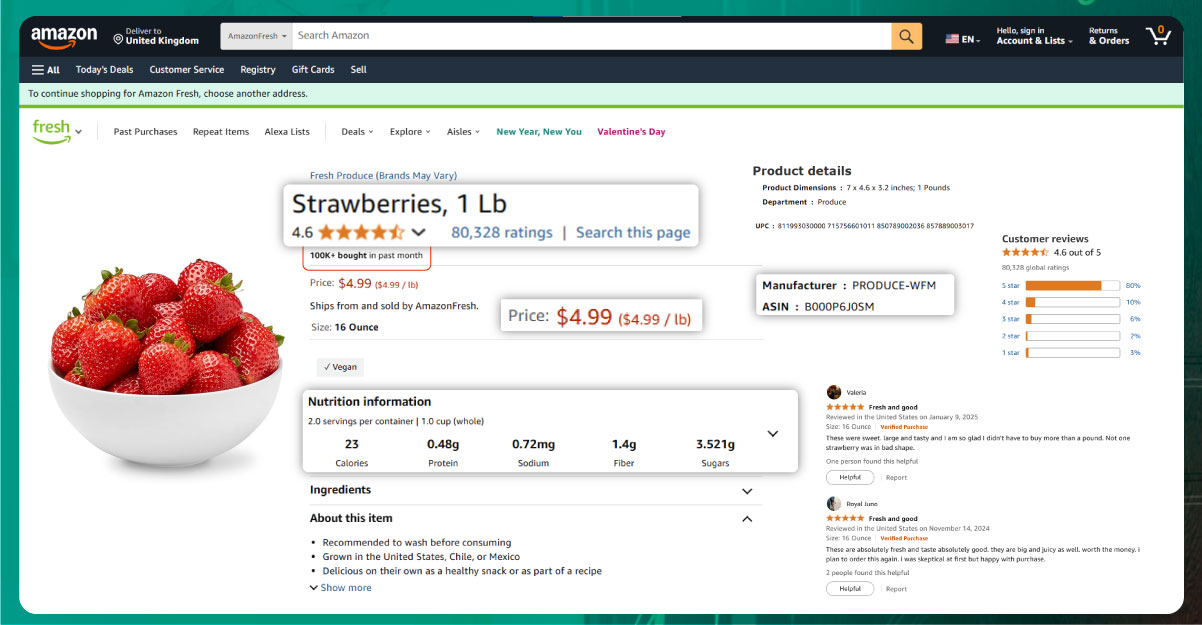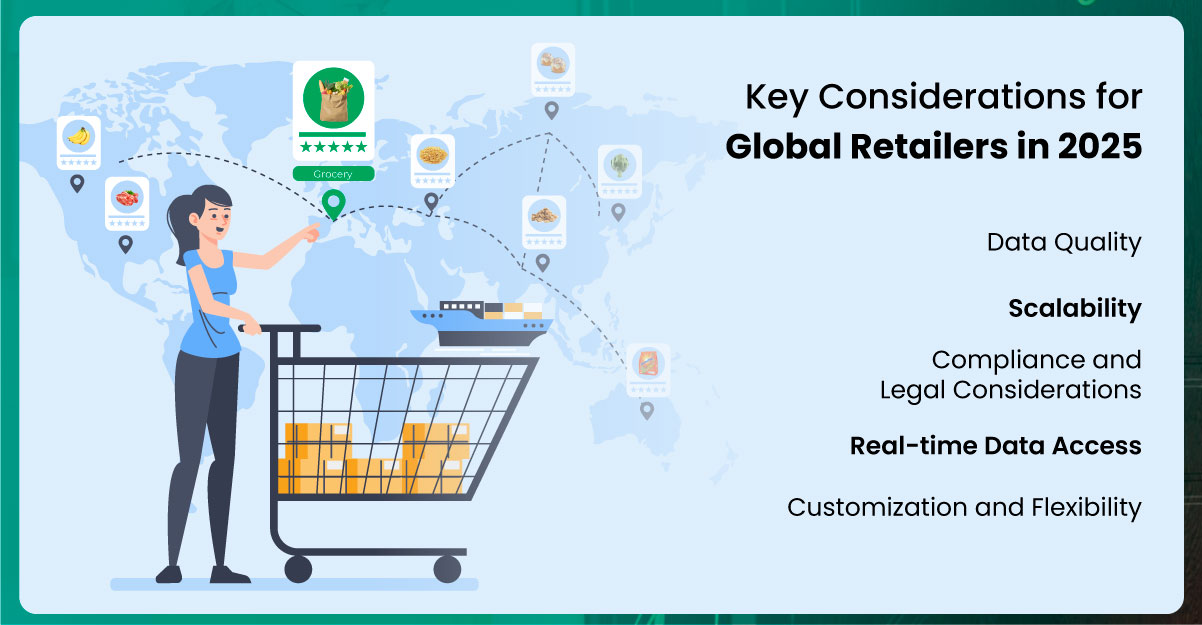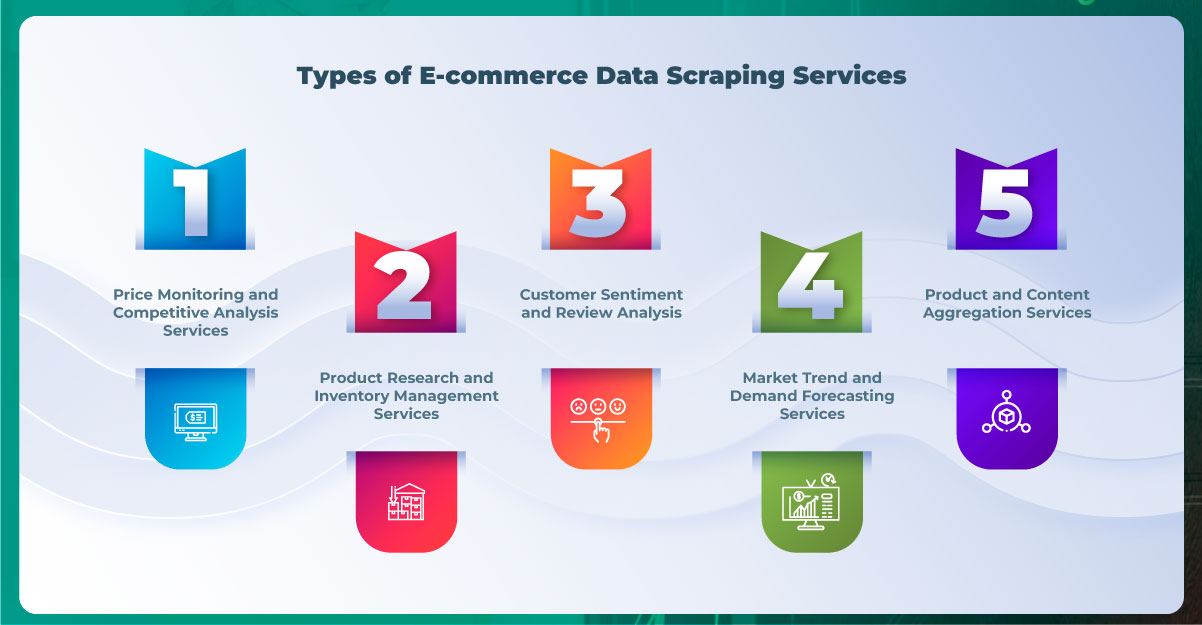
In 2025, the world of e-commerce is rapidly evolving, with retailers across the globe adapting to new consumer demands, technological innovations, and market dynamics. As the digital marketplace grows, so does the need for high-quality, actionable data to drive decision-making, competitive analysis, and strategic planning. For global retailers looking to stay ahead of the curve, e-commerce data scraping has become indispensable. It allows businesses to extract valuable insights from vast amounts of online information, ultimately helping them refine their marketing strategies, optimize inventory, and enhance customer experiences.
Web Scraping for Grocery Price Optimization has emerged as a key method for businesses to stay competitive. By extracting pricing information across various platforms, retailers can identify price fluctuations, monitor their competitors' pricing strategies, and adjust their pricing in real time. This proactive approach helps businesses maintain optimal pricing, maximizing profit margins while keeping customers satisfied with competitive offers.
For grocery retailers, data scraping is not only about monitoring competitors but also about understanding pricing strategies. Scrape Pricing Strategies for Grocery Retailers to help businesses analyze pricing trends within the grocery sector, ensuring they stay aligned with market dynamics. By collecting data on pricing for different categories of products, retailers can tailor their pricing models to meet consumer expectations while staying competitive in a crowded market.
Through these strategies, e-commerce data scraping provides insights into the most effective ways to adjust product pricing based on demand, competitor actions, and market shifts. This is particularly useful for retailers managing large product catalogs and operating across multiple platforms, as it allows them to optimize pricing strategies and increase sales performance.

At its core, e-commerce data scraping involves collecting, analyzing, and utilizing data from online stores, marketplaces, and other relevant digital sources. This data includes product details, prices, customer reviews, inventory levels, sales trends, competitor insights, etc. This information can be invaluable for retailers when crafting pricing strategies, understanding consumer preferences, tracking competitors' movements, and identifying emerging trends.
Web Scraping Real-Time Grocery Price Updates is essential for businesses aiming to stay on top of rapidly changing prices in the grocery sector. By accessing up-to-the-minute pricing data, retailers can adjust their strategies quickly, ensuring they remain competitive. This real-time access to pricing information allows businesses to fine-tune their offerings and avoid being outpaced by competitors, ultimately leading to better customer retention and increased sales. Data scraping also helps businesses monitor various external factors, such as pricing fluctuations, new product launches, and promotional campaigns that could impact their operations. Moreover, as more consumers turn to online shopping platforms for their purchasing decisions, retailers must stay agile and informed about what is happening in the marketplace.
This is where e-commerce data scraping comes into play, empowering businesses to access the real-time data necessary to remain competitive and meet consumer demands, including the ability to Extract Grocery Price Trends Data. By understanding the broader pricing trends, retailers can adjust their pricing models and promotions to attract more customers and optimize profit margins.

Before exploring the top e-commerce data scraping services, it is essential to understand the key considerations global retailers must consider when selecting a data scraping solution.
1. Data Quality: The primary goal of data scraping is to collect high-quality, accurate, and relevant information. Inaccurate or outdated data can lead to poor decision-making and negatively impact pricing strategies, customer engagement, and overall performance. Therefore, partnering with a service that prioritizes data integrity and offers consistent updates is crucial.
2. Scalability: As businesses grow and expand into new markets, their data scraping needs evolve. Retailers must choose a service that can scale with their business, handling increased data volumes, more complex websites, and new sources of information. A scalable service ensures that retailers can continue gathering valuable insights regardless of size or geographical reach.
3. Compliance and Legal Considerations: Data privacy regulations and legal frameworks surrounding data scraping are critical considerations for any business. Global retailers must ensure that their scraping services comply with relevant data protection laws, such as the General Data Protection Regulation (GDPR) in Europe or the California Consumer Privacy Act (CCPA) in the United States. It is essential to work with services that prioritize ethical practices and adhere to the legal requirements of different regions.
4. Real-time Data Access: In today's fast-paced e-commerce landscape, businesses cannot afford to rely on stale or delayed data. Real-time data scraping enables retailers to access up-to-the-minute information, empowering them to adjust their strategies quickly in response to market shifts. Real-time insights are essential for success, whether monitoring competitor prices or tracking inventory levels.
5. Customization and Flexibility: Every business has unique data needs based on product offerings, customer base, and geographical location. Retailers must seek data scraping services that offer customization and flexibility, allowing them to collect the specific data that is most valuable to their operations. This flexibility might include filtering data, scraping particular product categories, or adjusting the frequency of data collection.

Global retailers can choose from various e-commerce data scraping services tailored to different needs, goals, and business requirements. Based on the nature of the data they collect and the methods they use for extraction, these services typically fall into a few categories.
1. Price Monitoring and Competitive Analysis Services
Price monitoring is one of the most common uses for e-commerce data scraping. Retailers use these services to track competitors' pricing strategies, ensuring they stay competitive in the market. Data scraping services specializing in price monitoring can scrape product prices across various websites, including online marketplaces, retail stores, and brand websites, allowing businesses to adjust their pricing in real-time.
These services can also help retailers monitor promotional activities, discounts, and sales events, enabling them to make data-driven decisions about when to offer discounts or run sales. Moreover, the insights derived from price scraping can help retailers identify underpriced products or market gaps that they can exploit to increase sales.
2. Product Research and Inventory Management Services
Maintaining an optimal product inventory is crucial for e-commerce businesses. Scraping services focusing on product research and inventory management can gather detailed information about stock levels, product variations, and availability. This type of data scraping enables retailers to anticipate stock shortages, prevent overstocking, and make informed purchasing decisions.
These services also allow businesses to analyze customer preferences by scraping product attributes such as colors, sizes, and features. This data can guide product assortment decisions, ensuring that retailers offer the right products to meet market demand.
3. Customer Sentiment and Review Analysis
Customer feedback is an essential element in shaping retail strategies. Data scraping services focusing on reviews and ratings can collect sentiment analysis from customer feedback on various e-commerce platforms. This data can provide insights into customer satisfaction, product quality, and the effectiveness of marketing campaigns.
By monitoring online reviews and sentiment, global retailers can identify areas for improvement, address customer concerns proactively, and adjust their product offerings accordingly. Additionally, review scraping can provide valuable feedback on competitors' products, highlighting strengths and weaknesses businesses can use to differentiate themselves.
4. Market Trend and Demand Forecasting Services
Understanding market trends is key to staying ahead in the ever-changing retail environment. E-commerce data scraping services focused on market trends can help businesses track shifting consumer interests, seasonal demand patterns, and emerging product categories. These services scrape product launches, sales patterns, and trending items from various platforms to predict future demand and identify growth opportunities.
Demand forecasting through data scraping allows retailers to make smarter decisions about inventory, marketing strategies, and product development. By leveraging data insights, businesses can better prepare for peak sales seasons, ensuring they can meet consumer demand without overextending their resources.
5. Product and Content Aggregation Services
Global retailers often operate across multiple markets and platforms, requiring diverse products and content. Data scraping services specializing in product and content aggregation collect data from various sources, consolidating it into a centralized repository. This service is particularly beneficial for businesses that sell products across multiple e-commerce channels or operate in regions with varying product availability.
Aggregated data provides a comprehensive view of the competitive landscape, helping retailers refine their marketing strategies and optimize product catalogs. These services also help businesses manage product descriptions, images, and content to ensure platform consistency. By leveraging Grocery and Supermarket Datasets, retailers can track inventory levels, assess product performance, and gain insights into consumer preferences across different regions, helping them make informed decisions about product assortment and pricing strategies.

As we move into 2025, the landscape of e-commerce data scraping will continue to evolve, driven by advancements in AI, machine learning, and automation. Retailers will increasingly rely on AI-powered data scraping tools to enhance accuracy, speed, and efficiency. These tools will not only automate data collection but also offer advanced analytics capabilities to predict trends, personalize customer experiences, and optimize pricing strategies in real-time. Additionally, as consumer privacy concerns grow, retailers must prioritize ethical data collection practices and transparency. The future of e-commerce data scraping will likely see an increase in the integration of privacy-preserving technologies and compliance with stricter data protection regulations.
Extracting Real-Time Grocery Market Price data for grocery retailers will become even more crucial. Access to live market data will allow businesses to quickly adapt to changing consumer demands and optimize their product offerings. Real-time pricing data ensures that retailers can keep their pricing competitive while also offering promotions or discounts based on the most current market trends.
In conclusion, e-commerce data scraping has become an essential tool for global retailers in 2025. Its ability to gather critical insights, monitor competitors, and predict trends empowers businesses to make smarter, data-driven decisions. By choosing the right Grocery Data Scraping Services that align with their specific needs, retailers can gain a competitive edge, enhance operational efficiency, and deliver a better customer experience in an increasingly complex and fast-moving digital marketplace.
Experience top-notch web scraping service and mobile app scraping solutions with iWeb Data Scraping. Our skilled team excels in extracting various data sets, including retail store locations and beyond. Connect with us today to learn how our customized services can address your unique project needs, delivering the highest efficiency and dependability for all your data requirements.